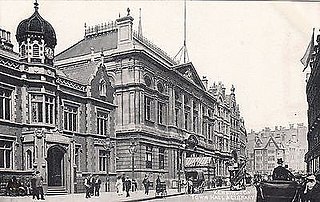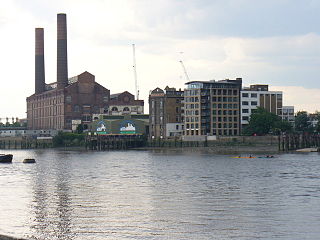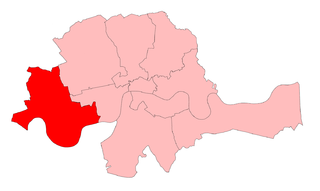
The Royal Borough of Kensington and Chelsea (RBKC) is an Inner London borough with royal status. It is the smallest borough in London and the second smallest district in England; it is one of the most densely populated administrative regions in the United Kingdom. It includes affluent areas such as Notting Hill, Kensington, South Kensington, Chelsea, and Knightsbridge.

Chelsea is an area of South West London, bounded to the south by the River Thames. Its river frontage runs from Chelsea Bridge along the Chelsea Embankment, Cheyne Walk, Lots Road and Chelsea Harbour. Its eastern boundary was once defined by the River Westbourne, which is now in a pipe above Sloane Square Underground station. The modern eastern boundary is Chelsea Bridge Road and the lower half of Sloane Street, including Sloane Square. To the north and northwest, the area fades into Knightsbridge and Brompton, but it is considered that the area north of King's Road as far northwest as Fulham Road is part of Chelsea.

Earl's Court is a district of Kensington in the Royal Borough of Kensington and Chelsea in West London, bordering the rail tracks of the West London line and District line that separate it from the ancient borough of Fulham to the west, the sub-districts of South Kensington to the east, Chelsea to the south and Kensington to the northeast. It lent its name to the now defunct eponymous pleasure grounds opened in 1887 followed by the pre–World War II Earls Court Exhibition Centre, as one of the country's largest indoor arenas and a popular concert venue, until its controversial closure in 2014. The area has long been known as "Bedsitter Land" with many of its stuccoed terraces converted into hotels and hostels.

The Metropolitan Borough of Kensington was a Metropolitan borough in the County of London from 1900 to 1965.

South Kensington is a district just west of Central London in the Royal Borough of Kensington and Chelsea. Historically it settled on part of the scattered Middlesex village of Brompton. Its name was supplanted with the advent of the railways in the late 19th century and the opening and naming of local tube stations. The area is known as a popular tourist destination owing to the density of museums and cultural landmarks. Adjacent affluent centres such as Knightsbridge, Chelsea and Kensington, have been considered as some of the most exclusive real estate in the world. Since World War I it has become a cosmopolitan area attracting Belgian and French refugees, but also Poles during World War II and after, and latterly Spanish, Italian, American, and Middle-Eastern expatriates. The French presence is emphasised by the Lycée Français Charles de Gaulle, the French Institute, hosting the Ciné Lumière a window on French cinema and the Alliance française and the French consulate, among other diplomatic residences. With a French bookshop and many international cafés in the area, it has been called Paris’s 21st arrondissement.

Counter's Creek, ending in Chelsea Creek, the lowest part of which still exists, was a stream that flowed from Kensal Green, by North Kensington and flowed south into the River Thames on the Tideway at Sands End, Fulham. Its remaining open watercourse is the quay of Chelsea Creek.

The Lillie Bridge Grounds was a sports ground on the Fulham side of West Brompton, London. It opened in 1866, coinciding with the opening of West Brompton station. It was named after the local landowner, Sir John Scott Lillie (1790–1868) and the Lillie bridge over the West London Line, that links Old Brompton Road with Lillie Road. The grounds were adjacent to the railway on the south side of Lillie Road. Although geographically near to present day Stamford Bridge, there was never direct access, there being the 13 acre now defunct Western Hospital site between the two. The ground was the scene in its day of many sports including athletics, boxing, cricket, cycling and football, and hosted the FA Cup Final in 1873. It closed in 1888 following a riot reported in The Times.

West Kensington, formerly North End, is an area in the ancient parish of Fulham, in the London Borough of Hammersmith and Fulham, England, 3.4 miles (5.5 km) west of Charing Cross. It covers most of the London postal area of W14, including the area around Barons Court tube station, and is defined as the area between Lillie Road and Hammersmith Road to the west, Fulham Palace Road to the south, Hammersmith to the north and West Brompton and Earl's Court to the east. The area is bisected by the major London artery the A4, locally known as the Talgarth Road. Its main local thoroughfare is the North End Road.

Brompton, sometimes called Old Brompton, survives in name as a ward in the Royal Borough of Kensington and Chelsea in London. Until the latter half of the 19th century it was a scattered village made up mostly of market gardens in the county of Middlesex. It lay south-east of the village of Kensington, abutting the parish of St Margaret's, Westminster at the hamlet of Knightsbridge to the north-east, with Little Chelsea to the south. It was bisected by the Fulham Turnpike, the main road westward out of London to the ancient parish of Fulham and on to Putney and Surrey. It saw its first parish church, Holy Trinity Brompton, only in 1829. Today the village has been comprehensively eclipsed by segmentation due principally to railway development culminating in London Underground lines, and its imposition of station names, including Knightsbridge, South Kensington and Gloucester Road as the names of stops during accelerated urbanisation, but lacking any cogent reference to local history and usage or distinctions from neighbouring settlements.

West Brompton is an area of south-west London, that straddles the boundary between the London Borough of Hammersmith and Fulham and Royal Borough of Kensington and Chelsea. The centuries-old boundary was traced by Counter's Creek, now lost beneath the West London Line railway.

Chelsea was a borough constituency, represented in the House of Commons of the Parliament of the United Kingdom.

Kensington South was a parliamentary constituency centred on the Kensington district of west London. It returned one Member of Parliament to the House of Commons of the Parliament of the United Kingdom.

George Godwin FRS was an influential architect, journalist, and editor of The Builder magazine.

The Boltons is a street and "Garden Square" of lens shape in the Brompton district of the Royal Borough of Kensington and Chelsea, London, England. The opposing sides of the street face the communal gardens with large expansive houses and gardens, in what is considered the third-most expensive street in the country with the average house price at 15 million pounds. The elliptical central gardens of the Boltons are Grade II listed on the Register of Historic Parks and Gardens.

Redcliffe Square is a town square located in the Brompton area of the Royal Borough of Kensington and Chelsea, southwest of central London,. Redcliffe Square Gardens are located in the square. The development was part of the vast Gunter estate, during 1864-1878.
Redcliffe Gardens is a primary road, the A3220 located in the Chelsea area of southwest central London, England. It was a development dated from 1864-1878.

Onslow Square is a garden square in South Kensington, London, England.
James Gunter was an English confectioner, market gardener and property developer who laid the foundations for what became one of the great residential estates in West London, developed by his descendants, the "Redcliffe Estate" and The Boltons in Little Chelsea and West Brompton.

The West London Hospital was founded in 1856 at as the Fulham and Hammersmith General Dispensary, which was housed in a small 6-roomed building in Queen Street, Hammersmith. It catered for acute conditions and later for geriatric, maternity, rehabilitation and long-stay conditions.

The Pettiward Estate is a privately owned set of reversions in the far edge of two inner boroughs of south-west London, England, now owned by a family trust of the family, who were from 1794 until 1935 of Finborough Hall, Suffolk. The family oversaw and took a direct involvement in much of the speculative development of these areas: parts of West Brompton and small parts of Putney.
















